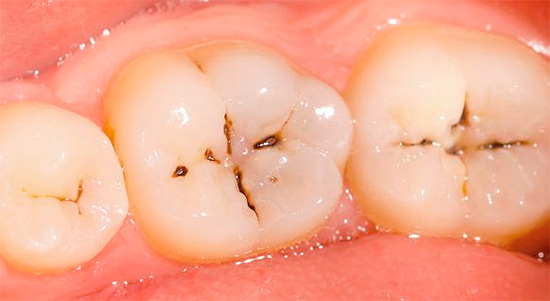
Two types of carious process can be distinguished: acute and chronic caries. Moreover, according to some researchers, this division of caries by the timing of formation and development is only of scientific interest - to study the processes occurring in the tissues of a carious tooth for a given period of time. We will be interested in this topic from the point of view of timely diagnosis of the carious lesion, treatment and prevention.
By and large, chronic caries is a characteristic of the general condition of the patient’s teeth. It can be described as the constant appearance of new lesions, their slow and inconspicuous development. Only in the later stages of the carious process (with moderate or deep caries) do characteristic symptoms appear that make a person go to the doctor.

Without a comprehensive fight, including proper dental care, correction of the diet and way of eating, as well as without eliminating other possible cariogenic factors, chronic caries is incurable - it will appear on the teeth constantly until the causes of its occurrence are eliminated.
Chronic caries is much more common than acute. By and large, almost any caries that does not have signs of a generalized disease is chronic with a particular rate of development. Many patients do not even take this disease seriously, considering tooth damage simply as some random misunderstanding, or as a matter of course.

From the experience of the dentist:
It should be noted that the acute and chronic course of caries is a mutually transforming process. In other words, they are so unstable that with changes in the body for a number of reasons acute caries can slow down, acquiring a chronic course, up to a temporary suspension. And vice versa, when the body is exposed to adverse factors, both external and internal (metabolic disturbances, physical illnesses, stress, hypothermia, gross nutritional disorders, etc.), chronic caries can quickly become acute.
That is why in practice it is practically impossible to accurately establish either the specific time of development of caries, or to distinguish one course from another according to the patient's complaints and external signs of the carious process. Often, acute caries has no symptoms in the oral cavity, since the damaged part of the tooth is located in a place inaccessible to external irritating factors. That is, the tooth decays quickly, but no pain is observed, which additionally causes difficulties in determining the activity of the carious process.
Chronic caries can also be observed in primary teeth. This is one of the most common diseases in children, since it can be difficult for parents to keep track of the condition of their teeth at an early age. Sometimes the dentist is faced with the problems of the acute course of caries, when in a few months the child's caries in the spot stage turns into deep violations of the tooth tissue. In this case, it is necessary to immediately stop its development by conducting complex treatment of all foci.

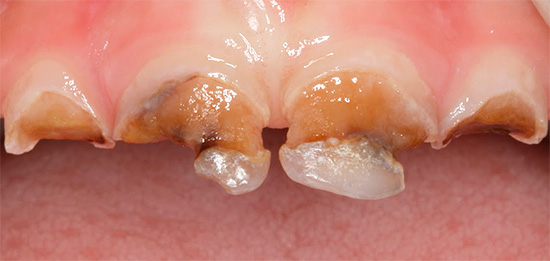
There is evidence that chronic caries in children can be determined already on erupted permanent teeth. The principle of its development is the same as in the milk bite.
The clinical picture and symptoms of the disease
A typical appearance of teeth with chronic caries is shown in the photo below:

There are no extensive lesions of the teeth, and in some places the dark areas are very small in size and often do not attract the attention of the patient. Usually pain is absent.
In some cases, even deep caries, having a chronic course, passes with minor symptoms, not to mention the initial stages of the carious process, when the disease can be treated without filling. This is partly due to the formation of replacement dentin, an adaptive reaction of a living tooth to the appearance of an infectious irritating focus, when secondary tissue forms that protects the nerve from external agents and irritants.

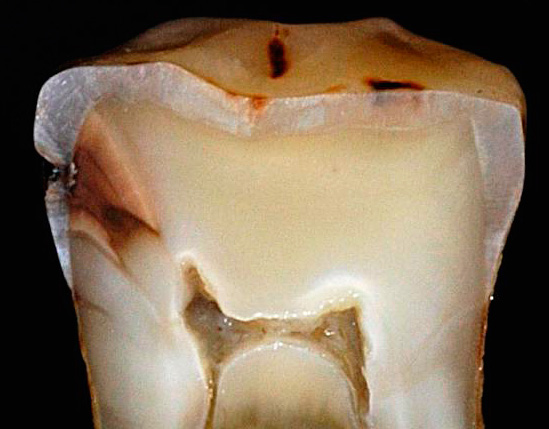
Almost never chronic caries does not lead to noticeable destruction of enamel, which is very characteristic of acute caries.
Feedback
“I go to the dentist all my life, as I remember. There is nothing particularly terrible, just constantly in one tooth or in another, holes appear, they have to be filled. Two teeth don't even have nerves. Only now, after 30 years, I came across a good dentist who explained everything well. I have chronic caries, only developing quite slowly. The teeth themselves are strong, but I brush them incorrectly and irregularly, so tooth decay also develops.
In general, I began to solve this problem. He completely healed all his teeth (a little more than 20,000 it cost me everything), bought a normal paste of ROX, a special conditioner that the doctor prescribed. For the third month now I’ve been using this all, brushing my teeth after every meal, and haven’t taken snacks. We’ll see if this gives a result. ”
Ilya, Moscow
At different stages of development, the picture of chronic caries has its own characteristics:
- Chronic caries at the spot stage almost does not manifest itself. A tooth may respond to cold foods or air, but this is not perceived by the patient as a pathology. The area of demineralized enamel looks like a whitish matte stain on the tooth.
- Chronic superficial caries leads to the formation of a cavity in the tooth enamel, but without dentin damage. Such a cavity has no overhanging edges, is wide, well open, the enamel itself usually darkens due to pigmentation, but retains a relatively high hardness.
- Chronic middle caries is characterized by a wide cavity affecting the dentin. In this course, the cavity does not have softened dentin, only pigmented carious dentin. The bottom is dense with slight ledges and roughness, which indicates a sluggish process in the stage of compensation due to replacement dentin.
- Chronic deep caries differs from the average only in the depth of the cavity. It also has no overhanging enamel edges, usually well polished.

At all stages of caries development, tapping on the affected area does not lead to pain. Percussion causes fast-passing pain only in the event of complications in the form of pulpitis or periodontitis.
From the practice of the dentist
With all types of caries, percussion does not cause pain. Pain with light tapping on the tooth is associated only with the complications of caries, and this is the main diagnostic sign that concerns the official differential diagnosis of caries according to the protocols.
In practice, sometimes with deep cavities located on the contact surfaces, the patient may have a kind of “food collector”. Food gets stuck here and causes gum injury. If the patient comes with an abundance of stuck food and inflammation of the gingival papilla, then when tapping the tooth (percussion) there will be sensitivity. But you need to understand that it can only hurt the gums, not a tooth. Caries here is only an indirect cause of pain during percussion. Usually in these cases they use additional methods of differential diagnosis. But this is a rare clinical situation, officially, with any caries, percussion is painless.
Causes of chronic caries
Generally speaking, chronic caries occurs for the same reasons that are characteristic of caries in general - due to the activity of bacteria that process carbohydrate residues in the mouth into organic acids. These acids regularly affect the enamel of the teeth and at one rate or another lead to its destruction. Then the dentin lying under the enamel is destroyed.

In most cases, the reason for the increased activity of cariogenic bacteria and contributing to the development of chronic caries is insufficient dental care. The slow course of the disease indicates that the tooth enamel of a healthy person is quite resistant to the action of cariogenic factors, and saliva successfully suppresses the activity of bacteria and restores the structure of enamel (saliva contains all the necessary chemical elements for this). Nature has already done everything possible to protect her teeth, and the development of the disease usually occurs only through the fault of the patient.
Chronic decay of deciduous teeth develops for the same reasons (one example is the so-called bottle caries). Often, procrastination of parents with accustoming the child to oral hygiene leads to the appearance of foci of the disease, which could have been avoided if elementary rules were observed - regular brushing and rinsing of the mouth after eating.

In addition, chronic caries in children is often not perceived by parents as a disease in general. Separate carious lesions are attributed to the fascination of children with sweets, and many parents do not pay attention to prevention and treatment, because they believe that if the baby’s teeth still fall out, then it’s not worth torturing the child at the dentist and spending money on treatment. Accordingly, the necessary measures are not taken on time, and as a result, single lesions become chronic.
Diagnosis of chronic caries
Diagnosis of chronic caries is usually with a simple visual examination of the appearance of carious areas. Sometimes the doctor concludes that the patient has chronic caries, at regular examinations of the patient, when he can assess the frequency of the appearance of new foci of tooth damage and the rate of development of the disease.

X-rays, transillumination, and luminescent diagnostics can be used to diagnose moderate and deep chronic caries, but usually there is no need to use them because of the visual state of the lesion foci.
On a note
Luminescent diagnostics are used to recognize initial caries. It can also be used as a diagnosis of caries complications, as an element of differential diagnostics. Transillumination will be unnecessary when the cavity is visible to the eye. An X-ray will be good for identifying hidden middle and deep cavities.
Treatment specifics
The treatment of chronic caries practically does not differ from that in acute caries. In most cases, it is limited to the removal of identified foci of caries without the use of long-term treatment methods.
Superficial and initial caries are treated by the method of remineralizing therapy with the use of calcium and fluorine preparations (that is, without the use of a drill). However, in some cases, grinding of the lesions with subsequent mineralization or even preparation of the tooth with subsequent filling is required.

With medium and deep caries, necrotic dentin and pigmented enamel are removed. If the resulting cleaned cavity is relatively small, it is disinfected, and then filled with filling material. With a large cavity or the destruction of one or more walls of the tooth, tabs or, in some cases, crowns are set.
In general, with deep caries, crowns are rarely installed.Tabs - more often, since they were originally conceived in terms of repeating the relief of the tooth anatomy and improving functions as opposed to conventional patch patches. Often tabs are placed and put on vital (live) teeth. With the modern development of aesthetic therapeutic dentistry, fillings and tabs are more important than crowns on vital teeth.

Feedback
“I seem to have chronic caries. He constantly appears in different teeth, every six months he regularly has to go to the doctor. But so far there hasn’t been anything particularly terrible, all the time only seals are put. "Never before have nerves been removed and crowns not set, although the doctor says that there may soon be a reason, because under the oldest fillings, caries may well develop."
Oksana, Kiev
The choice of treatment depends not only on the stage of development of the disease, but also on the age of the patient, the location of the cavity, the requirements for aesthetics of the filling material. For example, practice has shown that children who know what color fillings are and compete with each other in their brightness, very calmly and patiently tolerate manipulations with their teeth to just get such a bright filling.
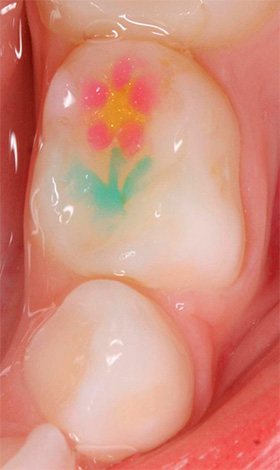
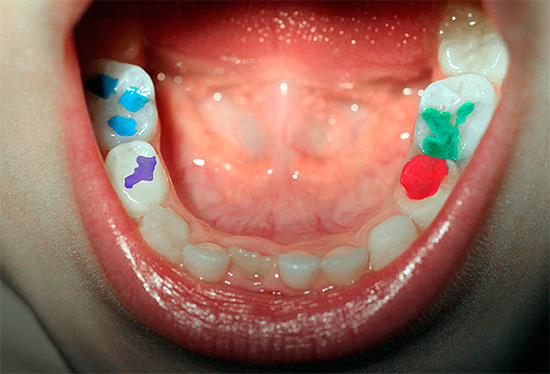
On a note
With the proper treatment of uncomplicated caries, there is never a situation when you need to remove a tooth. With the doctor’s egregious lack of professionalism, when his direct actions (creating a hole in the bottom of the tooth, excessive preparation under the gum), or errors in diagnosis and treatment, followed by transfer of caries to pulpitis, may lead to the need to remove the tooth. A good doctor can always save a carious tooth without pulpitis and periodontitis.
Theoretically, in chronic caries, the doctor does not need to use filling materials that release fluoride into the tooth cavity for a long time, and also engage in deep fluoridation and constant monitoring of the patient’s teeth. Due to the low rate of development of the process, the removal of carious sections provides protection against caries for a sufficiently long period, and the patient’s fluorine and calcium enamel are already received in sufficient quantities. Nevertheless, given the ability of caries to rapidly change from a chronic to an acute form, doctors sometimes prefer to play it safe and put insulating pads or fillings from glass-ionomer cements that release fluorides into the surrounding tissues. It will not be worse from this, but the benefit may well be.
Prevention of chronic caries
Prevention of chronic caries is aimed at eliminating the causes of its development - the removal of plaque on the teeth and dental plaques. To do this, you must:
- To brush your teeth at least twice a day with plaque-removing pastes, preferably with an average degree of abrasion. Well suited for this Elmex tooth decay paste, R.O.C.S. Caribbean summer and some other toothpaste for caries prevention.

- Limit the amount of sweet in the diet, eat coarse vegetables and fruits regularly.

- Brush your teeth after eating with floss; use sugar-free chewing gum.

- Regularly undergo examinations at the dentist, heal on time the emerging foci of caries.

Sometimes a doctor may prescribe the use of remineralizing gels and mouth rinses. You can not neglect these recommendations.
In children, chronic caries is prevented by the same methods. In infants up to 2 years old, the rules of prevention also include correction of the diet and the abolition of night feedings and meals before bedtime after brushing your teeth.
It is very important to teach children to brush their teeth on time: the smallest patients have less frequent chronic caries, and usually the disease is acute with a quick and large-scale damage to the teeth.
And most importantly - milk teeth in children need to be treated as diligently as permanent ones.A full set of healthy milk teeth is the main guarantee of the normal formation of the jaws in the child, and the grafted skills in caring for the teeth guarantee the child protection from chronic caries in adulthood.
Remember: dental health starts from childhood, and parents' attention to it will give much more than even the most professional and high-quality treatment.
Interesting video: why caries occurs and how to protect yourself from it
And here, in fact, is the treatment of deep caries using a drill






